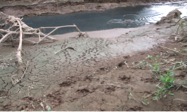Strategies to protect riparian forest against damage caused by capybaras.
Submitted by editor on 15 August 2014.
Capybara (Figure 1) damage is closely associated with proximity to water bodies and forested areas ( Figure 2 )

Figure 2 : The capybaras footprints in slope, close to the riparian forest
The Capybara's population has increased in riparian forest as a result of the lack of predators and their main impact is over agriculture and forested areas. Thus, Capybaras have compromised the early stages of succession of riparian forested sites particularly by the trampling they cause over young plants of woody species. Therefore, damage control management practices are required. In our study "Strategies for herbivory mitigation by capybaras (Hydrochaeris hydrochaeris) in a riparian forest under restoration in the São Francisco river basin, Brazil", Guimarães et al (2014) investigated the potential use of diversionary feeding to mitigate the herbivory impacts of capybaras (Hydrochoerus hydrochaeris) on a newly cultivated riparian forest in the watershed of the Velhas River, the main tributary of the São Francisco River in southeastern Brazil.
Paspalum notatum and Helianthus annuus cultivated in riparian forest (Figure 3 and 4) were used as diversionary feeding to supply food to Capybaras and to divert them away from the young plants of riparian forest under restoration.

Figure 3: Plots cultivated with P. notatum

Figure 4: Plots cultivated with H. annuus
Capybaras distinctly preferred Paspalum notatum, which suffered 8.14-fold greater damage than other species ( Eg. Helianthus annuus) and suffered coverage losses of up to 40% outside of the control plots. P. notatum was efficient at attracting and concentrating the interest of capybaras (Figures 5 and 6) and therefore is a promising species to protect the riparian forest in the early stages of cultivation. (Figure 7).

Figure 5 Recording the presence of capybaras in the experimental area: herbivory

Figure 6 Recording the presence of capybaras in the experimental area: scats

Figure 7: View of forest 12 months after transplantation